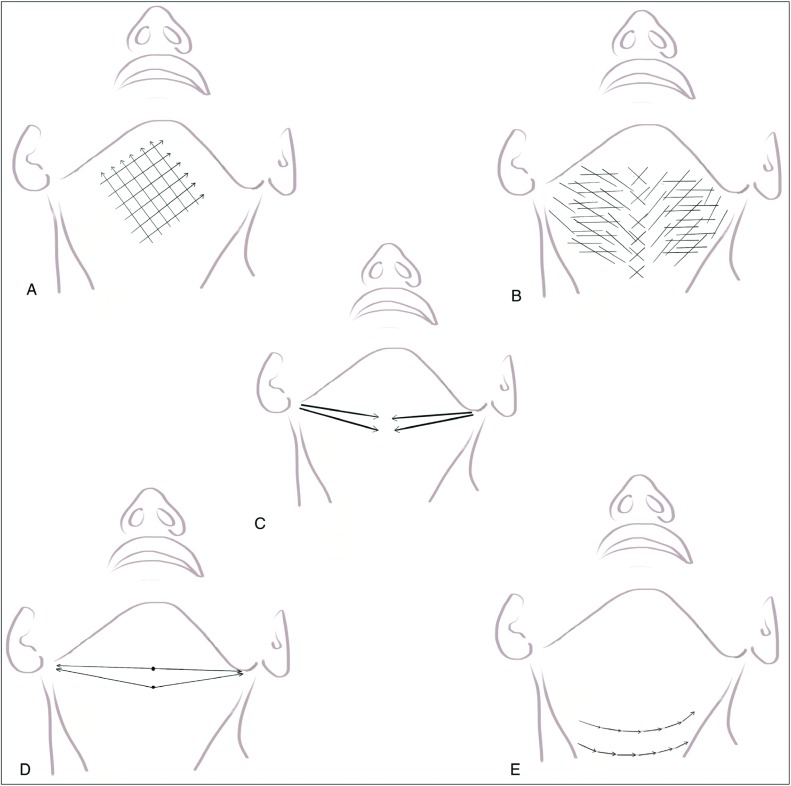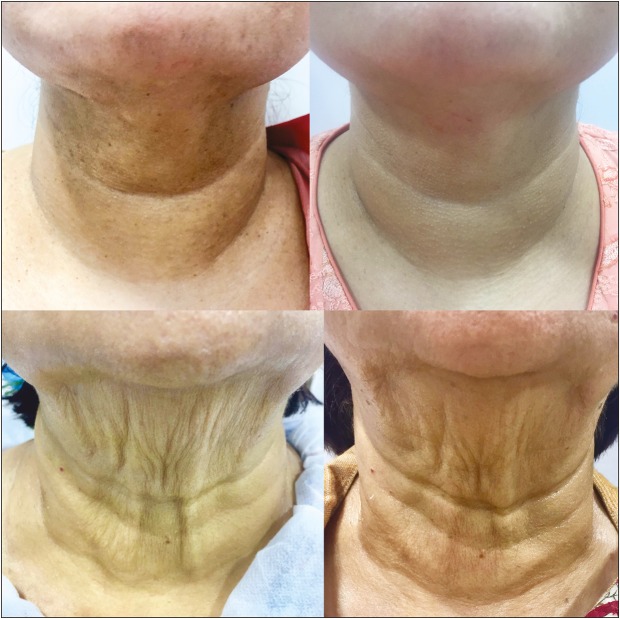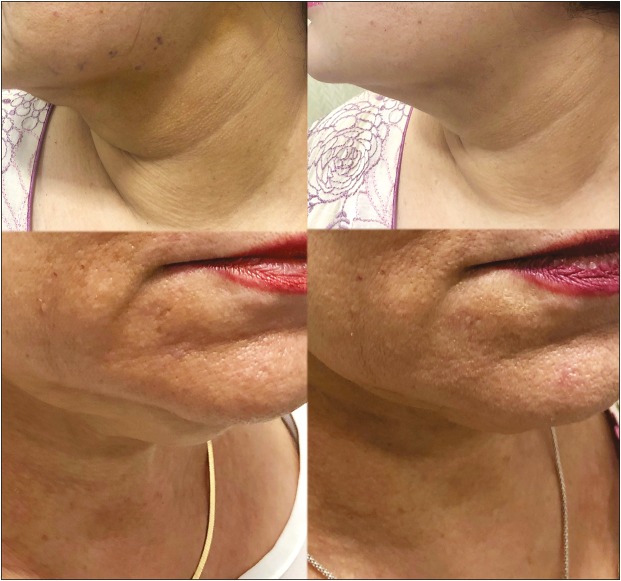Aging is a universal phenomenon and inevitable. Skin too ages just as other organs of the body. In addition to generic body aging, extrinsic factors such as sunlight (visible, ultraviolet, and infrared), smoking, and air pollution induce aging due to their direct impact along with ethnic skin characteristics, which are unique to individuals.[1] In addition to these, age-related structural changes in the bones, ligaments, fat pads, muscles, and skin all add to the aged skin look. Neck region is a perfect example of how skin in an exposed area is affected by all the above factors, resulting in textural changes with wrinkled blotchy, loose, inelastic, sagging skin; increase in neck volume with platysmal bands and Venus rings; and/or blunting of the cervicomental angle.[2]
Chronological aging cannot be prevented. It can be delayed and accepted in a more elegant manner, whereas photoaging may be prevented to a certain extent by the use of the correct amount of sunblock starting at the right age. However, structural correction, which is just as important, can be addressed to take care of the third inevitable change, which needs correction of superficial as well as deep layers to get a natural and harmonious result.[3]
Twenty female patients with various signs of neck aging that attended a dermatology center between March 2017 and June 2018 were treated for neck rejuvenation using different types of threads. Those having received any other cosmetic procedure for neck rejuvenation, history of keloidal or bleeding tendencies, and pregnant and lactating patients were excluded.
Neck aging assessment, in the form of neck wrinkling was carried out by six-point wrinkle assessment scale by Lemperle et al.[4] (0: no wrinkles, 1: just perceptible wrinkle, 2: shallow wrinkle, 3: moderately deep wrinkle, 4: deep wrinkle with well-defined edges, and 5: very deep wrinkle with redundant fold) and in the form of neck volume was carried out by five-point assessment scale by Sattler et al.[5] [Figure 1]. All cases were photographed pre-procedure and at 3 months post-procedure.
Figure 1.
Sattler, neck volume five-point assessment scale
The most common signs of the neck aging treated were wrinkling of the neck skin, textural changes, platysmal bands, and double chin. Five patients with double chin and obliteration of the cervicomental angle were initially treated with two sessions each of injection lipolysis with deoxycholate, followed by threads. Three patients with excessive cord-like platysmal banding were initially treated with botulinum toxin, followed by neck rejuvenation with threads. We used both polydioxanone (PDO) (mono, screw, and barbed) as well as poly l-lactic acid (PLLA) threads with bidirectional cones. Choice of thread used was based on the primary indication.
When just rejuvenation of the neck in terms of textural improvement was desired, monofilament or screw PDO threads were used, as these threads improve microcirculation and collagenosis and thus the texture of the skin and mild wrinkling is corrected. When reduction in volume due to a double chin was desired, monofilament PDO threads were used in a crosshatch technique to aid in lipolysis, along with tightening the skin, thus attempting to restore the optimal cervicomental angle.[6] To improve sagging and severe wrinkling, more stretch in the horizontal plane was desired, and hence to redrape the skin, we used PDO bidirectional barbed or PLLA bidirectional cone threads.
To give a long-lasting result, PLLA was chosen over PDO threads in patients who could afford, as it has a longer half-life of 18 months as compared to 6 months of PDO. A crosshatch technique was used where more surface area was required to give greater textural improvement and also as optimal vectors for double chin. A hammock technique was used to stretch the skin where laxity was more, and to give a good anchoring at the mastoid fascia. Linear threading was used where just volumization with threads was desired as in Venus rings [Figure 2].
Figure 2.
Techniques used for thread insertion. (A, B) Crosshatch. (C, D) Hammock. (E) Linear threading
Procedural steps followed were as follows: Topical anesthesia using eutectic mixture of prilocaine and lidocaine was used as a local anesthetic for 1h before PDO under aseptic precautions. For insertion of cog threads, local infiltration using 2% lignocaine with adrenaline 1:200,000 was given for points of insertion and an 18-gauge needle was used to make the entry point. Thread insertion was thereafter done under aseptic precautions.
Post-procedure advice included ice pack application for the anticipated swelling and edema. Capsule amoxicillin (625mg) with clavulanic acid (125mg) was given three times a day for 5 days. Patients were advised against wide mouth opening for 48h and to abstain from smoking, vigorous exercises, and cosmetic procedures in the treated area for a week.
Results were assessed based on the patients’ response to treatment and recorded according to the visual analog scale (VAS) (4+, >75% improvement; 3+, 50%–75% improvement; 2+, 25%–50% improvement; 1+, 0%–25% improvement; and no response). Neck wrinkling and volume assessment change as per the aforementioned scales were also carried out and compared using the paired t-test. Complications, if any, were recorded.
Twenty female patients were treated [Table 1] [Figures 3 and 4]. The mean pre-procedure neck wrinkling and volume assessment was 3.65 and 2.45, whereas post-procedure was 1.4 and 1.1. These were statistically significant (P < 0.0001 and P < 0.001). Fifteen cases were satisfied with their procedure (VAS >2+), whereas one failed to respond due to severe platysmal laxity. Post-procedure bruising was seen in 11 cases and edema was observed in all as a sequela, which lasted for 48–72h. No other complications were observed.
Table 1.
Summary of cases and pre- and post-procedure assessment
| Serial number | Age (years) | Sign of aging | NW grade pretreatment | NW grade posttreatment | NV grade pretreatment | NV grade posttreatment | VAS | Types of thread used |
|---|---|---|---|---|---|---|---|---|
| 1 | 35 | Textural change | 1 | 0 | 0 | 0 | 4+ | Monofilament |
| 2 | 58 | Wrinkling + platysmal bands | 4 | 2 | 3 | 2 | 2+ | Screw |
| 3 | 45 | Wrinkling + Double chin | 4 | 2 | 4 | 2 | 4+ | Monofilament |
| 4 | 44 | Venus rings | 5 | 2 | 1 | 0 | 3+ | Monofilament + screw |
| 5 | 52 | Wrinkling + textural changes | 4 | 2 | 2 | 1 | 2+ | Monofilament |
| 6 | 46 | Wrinkling + textural changes | 3 | 1 | 2 | 1 | 4+ | Screw |
| 7 | 35 | Textural change | 1 | 0 | 0 | 0 | 4+ | Monofilament |
| 8 | 60 | Wrinkling + platysmal bands | 5 | 2 | 4 | 3 | 2+ | Screw |
| 9 | 44 | Textural changes + wrinkling | 4 | 1 | 2 | 0 | 4+ | Cog + monofilament |
| 10 | 48 | Wrinkling + neck sagging | 3 | 1 | 2 | 1 | 4+ | PLLA |
| 11 | 52 | Wrinkling + platysmal bands | 5 | 3 | 4 | 3 | 1+ | Cog |
| 12 | 37 | Textural change | 3 | 0 | 0 | 0 | 4+ | Monofilament |
| 13 | 63 | Wrinkling + platysmal bands | 4 | 2 | 3 | 2 | 3+ | Cog + monofilament |
| 14 | 45 | Wrinkling + textural changes | 4 | 1 | 2 | 0 | 3+ | Cog |
| 15 | 44 | Wrinkling + double chin | 3 | 1 | 3 | 1 | 3+ | Cog |
| 16 | 52 | Wrinkling + turkey neck | 4 | 2 | 4 | 2 | 3+ | PLLA |
| 17 | 49 | Wrinkling + turkey neck | 5 | 3 | 4 | 1 | 3+ | PLLA |
| 18 | 41 | Wrinkling + double chin | 2 | 0 | 1 | 0 | 4+ | Cog |
| 19 | 52 | Wrinkling + double chin + turkey neck | 4 | 1 | 4 | 2 | 3+ | Cog + monofilament |
| 20 | 47 | Wrinkling + double chin + turkey neck | 5 | 2 | 4 | 2 | 2+ | Monofilament + PLLA |
NW = neck wrinkles, NV = neck volume, VAS = visual analog scale
Figure 3.
Pre-procedure (left) and post-procedure (right) of cases 3 (above) and 8 (below)
Figure 4.
Pre-procedure (left) and post-procedure (right) of cases 17 (above) and 19 (below)
PDO and PLLA threads stimulate fibroblast, collagenization, and neo-angiogenesis, which improve the skin texture and laxity. Repeat sessions may be needed similar to other aesthetic procedures to achieve and maintain the desired result. They can thus be used for improving skin texture as well as wrinkling and laxity to achieve the ideal aesthetic appeal: skin of the neck and face to be in sync, with minimal discomfort or downtime.
Declaration of patient consent
The authors certify that they have obtained all appropriate patient consent forms. In the form the patient(s) has/have given his/her/their consent for his/her/their images and other clinical information to be reported in the journal. The patients understand that their names and initials will not be published and due efforts will be made to conceal their identity, but anonymity cannot be guaranteed.
Financial support and sponsorship
Nil.
Conflicts of interest
There are no conflicts of interest.
References
- 1.Dibernardo BE. The ageing neck: a diagnostic approach to surgical and nonsurgical options. J Cosmet Laser Ther. 2013;15:56–64. doi: 10.3109/14764172.2012.758383. [DOI] [PubMed] [Google Scholar]
- 2.Ellenbogen R, Karlin JV. Visual criteria for success in restoring the youthful neck. Plast Reconstr Surg. 1980;66:826–37. doi: 10.1097/00006534-198012000-00003. [DOI] [PubMed] [Google Scholar]
- 3.Rohrich RJ, Rios JL, Smith PD, Gutowski KA. Neck rejuvenation revisited. Plast Reconstr Surg. 2006;118:1251–63. doi: 10.1097/01.prs.0000209406.80690.9f. [DOI] [PubMed] [Google Scholar]
- 4.Lemperle G, Holmes RE, Cohen SR, Lemperle SM. A classification of facial wrinkles. Plast Reconstr Surg. 2001;108:1735–50. doi: 10.1097/00006534-200111000-00048. discussion 1751-2. [DOI] [PubMed] [Google Scholar]
- 5.Sattler G, Carruthers A, Carruthers J, Flynn TC, Geister TL, Görtelmeyer R, et al. Validated Assessment Scale for neck volume. Dermatol Surg. 2012;38:343–50. doi: 10.1111/j.1524-4725.2011.02253.x. [DOI] [PubMed] [Google Scholar]
- 6.Swaminathan V. Polydioxanone thread lifting: considerations and patient expectations. J Aesthet Nurs. 2016;5:70–3. [Google Scholar]






